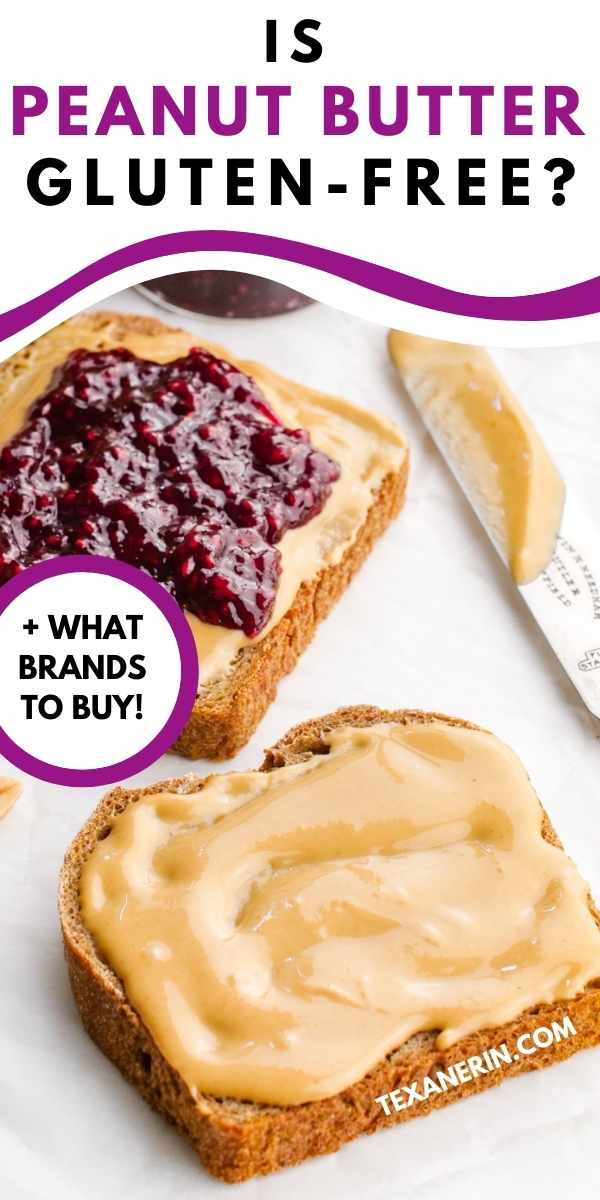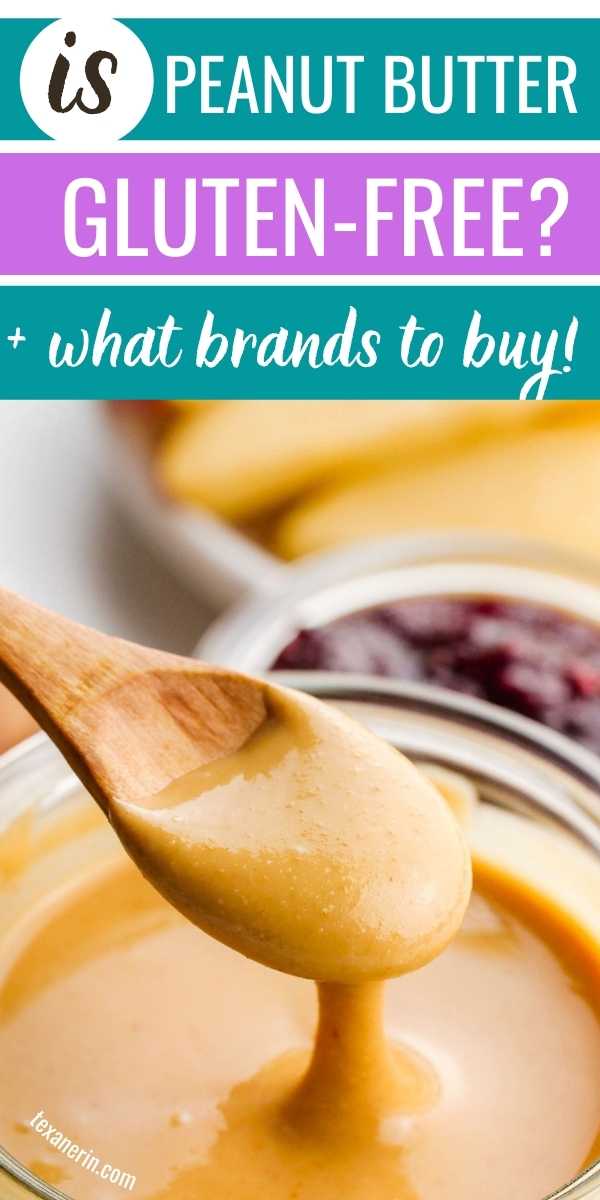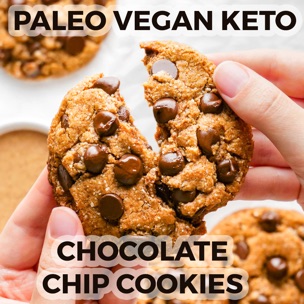Is peanut butter gluten-free? Usually, it is, but there are some things you have to watch for. I’ve included a list of brands safe for celiacs and anyone on a gluten-free diet.
Adjusting to a gluten-free diet can be difficult at first. While there are plenty of amazing gluten-free products on store shelves today, gluten can also be found in a wide range of sources. You can’t just stay away from bread and pasta. You’ll also have to watch out for some sauces, beverages, and even supplements.
Peanut butter is popular with kids and adults alike, which is why many people want to know if it’s safe for people with celiac disease or gluten intolerance to eat. Peanuts don’t contain any gluten in their natural form, but you’ll still want to check the labels before making yourself a peanut butter sandwich.
In addition to peanuts, oil, salt, and some sort of sweetener is used in the manufacturing of peanut butter. For the most part, the jars of peanut butter that you can find at grocery stores will be gluten-free. However, products that have many additional ingredients may have an ingredient that does contain gluten.
It’s also possible that a peanut butter product is manufactured in a factory that also makes wheat products. This means there could be trace amounts of gluten in the peanut butter. People that are very sensitive to gluten will want to take additional precautions to avoid cross-contamination.
Cross-contamination
Although most brands of peanut butter don’t contain any gluten ingredients, they could be manufactured and packed in a facility that produces gluten-containing products. Or it could even be processed using the same equipment as gluten products.
The problem is that that equipment may or may not be cleaned when they switch from product to product. This could possibly lead to cross-contamination.
And that’s why, if you’re very sensitive to gluten, you’ll want to buy a brand that’s labeled as gluten-free or even certified gluten-free.
Difference between certified and labeled gluten-free?
To be certified gluten-free, products are required to contain less than 10ppm of gluten to become certified. If you’re extremely sensitive to gluten, you might want to look out for this seal on any products you buy.
There are five different seals and they all say GF or gluten-free certified (or certification) on them.

The last two belong to the same certification program. You can see the one in all black on some products that haven’t changed their packaging recently. The new one is on the right (the last one in the photo).
For products to legally be labeled gluten-free in the United States, they must first meet the requirements of the FDA of being less than 20ppm gluten. When products are tested to be less than 20ppm gluten, they may be labeled as such.
20ppm is still considered to be safe for celiacs.
Just like getting organic certification, it costs a lot of money to become gluten-free certified. And companies have to pay that fee yearly. So perhaps that’s why some companies don’t go the extra mile.
Companies that are in a dedicated facility might also feel like it’s not needed as there really shouldn’t be any gluten floating around.

Gluten-free peanut butter brands
The easiest way to find a safe product is to look for one that has the words “gluten-free” on the label. You can also seek out products that have been identified as gluten-free, like
Certified gluten-free peanut butters
The following information is correct as of January 2022. I went to each company’s website or looked at product packages to confirm if they were labeled gluten-free or certified gluten-free. If you look at other websites, you might find outdated information.
But even if buy your peanut butter the day after I post this, you should still check your labels.
It’s important to keep in mind that recipes can change from time to time and that there are going to be times where an ingredient may not be readily available, so the company swaps an ingredient that may contain gluten. I think that this is highly unlikely with peanut butter, but you never know.
Learn to check labels before purchasing products. Even if the product was gluten-free last week, it may not be gluten-free this week. It’s easy to accidentally ingest gluten if you’re not keeping a close eye on those ingredient lists.
- Crazy Richard’s
- MaraNatha
- Once Again
- Santa Cruz Organic
- Justin’s
- Peanut Butter & Co
Peanut butters labeled as gluten-free
Thank goodness that some of the most popular brands of peanut butter have gone to the effort of getting tested!
- Peter Pan
- Skippy
- Jif – this is an odd one! They say on their website that “The vast majority of our peanut butters are certified gluten-free. We encourage you to look for gluten-free claim on the back label of your jar for the most accurate information.“
But I don’t think they actually mean certified – I think they mean labeled.
Brands not labeled as gluten-free
These brands don’t use any gluten ingredients but haven’t been tested, and you, therefore, can’t assume that they’re safe.
If you’re super sensitive to gluten, you might want to avoid these. If you’re “just” intolerant, then these might be just fine!
- Adam’s
- Goober they don’t meet the standards for gluten-free labeling
- Laura Scudder’s
- Kirkland
- Smucker’s (some other blogs have said that Smuckers is labeled as gluten-free, but Smuckers themselves have said that they’re not! And I also don’t see it anywhere on their product labels.)
- Smart Balance
- Teddie
- Trader Joe’s
If your favorite brand of peanut butter isn’t on this list, try contacting the product manufacturer. They should be able to answer your questions and tell you more about the facilities where their products are made.
Also, if you need to avoid dairy, check out Is Peanut Butter Dairy-free?
And for the vegans, I’ve got Is Peanut Butter Vegan?

Tips for avoiding gluten
If you’re new to a gluten-free diet, and you’re having a hard time adjusting, you’ll want to look for products that are certified as gluten-free whenever possible. To receive this certification, products must be made in a facility where wheat products are not produced.
You should also take the time to go through your pantry and clean out any foods that have been there for a while. There’s a good chance that you’re holding onto foods that would cause issues for you. Soy sauce and salad dressings frequently cause problems for people that can’t digest gluten.
You don’t have to say goodbye to foods you’re a fan of, but you may want to make a few positive changes to your diet. Try to eat more produce. Cook food from scratch as much as you can. That way, you can control what goes in it!
Finally, you should make sure that you’re familiar with all of the different names for gluten-containing grains. You can’t just scan labels and look for the word “wheat.”
You should also be careful about eating products that contain:
- Barley
- Durum
- Einkorn
- Emmer
- Farina triticale
- Farro or faro
- Graham flour
- Kamut
- Malt
- Seitan
- Semolina
- Soy Sauce
- Spelt (also know an dinkel)
- Teriyaki Sauce
- Wheat (bran, germ and starch)
These are just the most common. If you’re looking at a package and unfamiliar with an ingredient, google is before buying.
It’s also smart to look out for additives, such as maltodextrin and corn starch. These ingredients are often hidden sources of gluten. Eventually, you’ll be able to stock your pantry will all kinds of tasty and appealing foods that are completely free of gluten.
Is peanut butter gluten-free? The majority of products you’ll see are safe to eat, but that doesn’t mean that you shouldn’t be cautious! By reading labels, sticking to safe products, and contacting manufacturers when you need to, you’ll be able to stay away from gluten without having to give up the foods that you love most.


